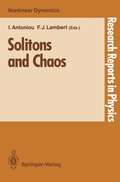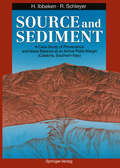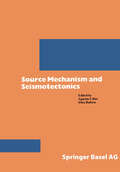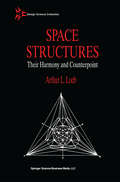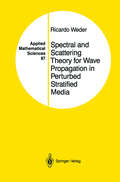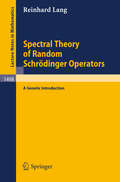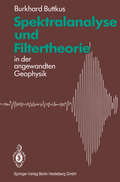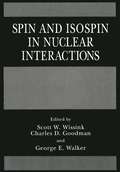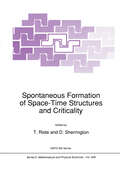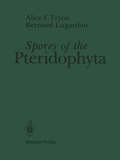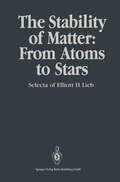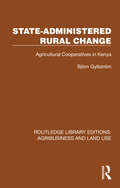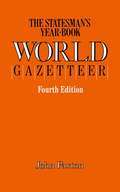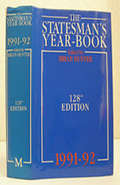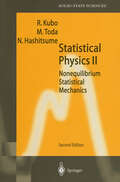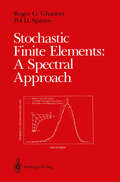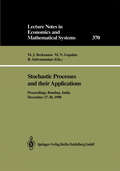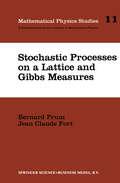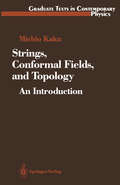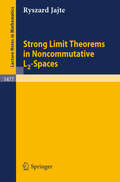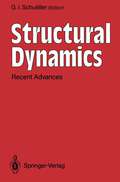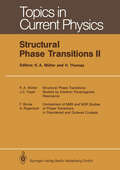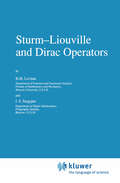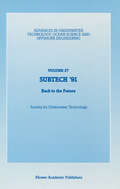- Table View
- List View
Solitons and Chaos (Research Reports in Physics)
by Ioannis Antoniou Franklin J. Lambert"Solitons and Chaos" is a response to the growing interest in systems exhibiting these two complementary manifestations of nonlinearity. The papers cover a wide range of topics but share common mathematical notions and investigation techniques. An introductory note on eight concepts of integrability has been added as a guide for the uninitiated reader. Both specialists and graduate students will find this update on the state ofthe art useful. Key points: chaos vs. integrability; solitons: theory and applications; dissipative systems; Hamiltonian systems; maps and cascades; direct vs. inverse methods; higher dimensions; Lie groups, Painleve analysis, numerical algorithms; pertubation methods.
Source and Sediment: A Case Study of Provenance and Mass Balance at an Active Plate Margin (Calabria, Southern Italy)
by Hillert Ibbeken Ruprecht SchleyerDeciphering provenance - this is the study of how far geology, geomorphology and climate of a source, a mountainous area, may be reconstructable from its erosional products released to the sea; from gravel and sand, from silt, sand, clay which recombine to form a new cycle of rocks. The purpose of this book is to give a quantitative picture of both source and sediment and the masses involved in the flux of material; based on a modern case study in Calabria, southern Italy, a mountain range which is part of an active plate margin. High erosion rates in the past (200mm/ka), and dramatic ones at present (1500mm/ka), make the area a powerful source of sediment comparable to orogenic conditions of the geological past. The book presents the first systematic, quantitative and data-bank supported study - here a larger source with small rivers and their sedimentary products - of the complex topic of provenance of terrigenous sediments and related mass balances at an active plate margin. It may serve as an orientation for corresponding research in other plate tectonic realms.
Source Mechanism and Seismotectonics (Pageoph Topical Volumes)
by UDIAS BUFORNnesus, Armenia, and Georgia have largely profited from the experience acquired in the study of the large events of the early 1980s. The Mediterranean region is not only the site of shallow dispersed seismic activity, it is also the site of localized intermediate depth seismic activity, and of some rare deeper events. Active subduc tion is clearly at the origin of Greek intermediate depth seismicity, while the deep activity under Calabria and the Vrancea region in Romania is clearly related to downgoing slabs that have long remained active after the arrest of subduction. The origin of the intermediate and very deep seismicity below Spain is a considerably more complex problem. Several possible explanations of the intermediate depth activity to about 110 km have been proposed, but the origin of the deep (650 km) events studied by BURFORN et a1. remains a mystery since this is the only source of deep activity that is not related in an obvious way to a subduction zone. The problem of seismic source mechanism and seismotectonics cannot be completely separated from that of the mechanical origin of earthquakes. Recent work on this subject has revealed the intimate relation between fault geometry, as observed by field geologists, and the results of inversion of source process from seismic data in the far-field or in the near-field.
Space Structures (Design Science Collection)
by A. Loebxiv aggregates: this touches on the very nature of things. The concept of statistical symmetry which Loeb develops is particularly important, it emphasizes the limitations in seemingly random aggregates and for permits general statements of which the crystallographer's sym metries are only special cases. The reductionist and holistic approaches to the world have been at war with each other since the times of the Greek philosophers and before. In nature, parts clearly do fit together into real structures, and the parts are affected by their environment. The problem is one of understanding. The mystery that remains lies largely in the nature of structural hierarchy, for the human mind can examine nature on many different scales sequentially but not simultaneously. Arthur Loeb's monograph is a fundamental one, but one can sense a devel opment from the relations between his zero-and three-dimensional cells to the far more complex world of organisms and concepts. It is structure that makes the difference between a cornfield and a cake, between an aggregate of cells and a human being, between a random group of human beings and a society. We can perceive anything only when we perceive its structure, and we think by structural analogy and comparison. Several books have been published showing the beauty of form in nature. This one has the beauty of a work of art, but it grows out of rigorous mathematics and from the simplest of bases-dimensional ity, extent and valency.
Spectral and Scattering Theory for Wave Propagation in Perturbed Stratified Media (Applied Mathematical Sciences #87)
by Ricardo WederThe propagation of acoustic and electromagnetic waves in stratified media is a subject that has profound implications in many areas of applied physics and in engineering, just to mention a few, in ocean acoustics, integrated optics, and wave guides. See for example Tolstoy and Clay 1966, Marcuse 1974, and Brekhovskikh 1980. As is well known, stratified media, that is to say media whose physical properties depend on a single coordinate, can produce guided waves that propagate in directions orthogonal to that of stratification, in addition to the free waves that propagate as in homogeneous media. When the stratified media are perturbed, that is to say when locally the physical properties of the media depend upon all of the coordinates, the free and guided waves are no longer solutions to the appropriate wave equations, and this leads to a rich pattern of wave propagation that involves the scattering of the free and guided waves among each other, and with the perturbation. These phenomena have many implications in applied physics and engineering, such as in the transmission and reflexion of guided waves by the perturbation, interference between guided waves, and energy losses in open wave guides due to radiation. The subject matter of this monograph is the study of these phenomena.
Spectral Theory of Random Schrödinger Operators: A Genetic Introduction (Lecture Notes in Mathematics #1498)
by Reinhard LangThe interplay between the spectral theory of Schr|dinger operators and probabilistic considerations forms the main theme of these notes, written for the non-specialist reader and intended to provide a brief and elementaryintroduction to this field. An attempt is made to show basic ideas in statu nascendi and to follow their evaluation from simple beginnings through to more advanced results. The term "genetic" in the title refers to this proceedure. The author concentrates on 2 topics which, in the history of the subject, have been of major conceptual importance - on the one hand the Laplacian is a random medium and the left end of its spectrum (leading to large deviation problems for Brownian motion and the link to thenotion of entropy) and on the other, Schr|dinger operators with general ergodic potentials in one-dimensional space. Ideas and concepts are explained in the simplest, possible setting and by means of a few characteristic problems with heuristic arguments preceding rigorous proofs.
Spin and Isospin in Nuclear Interactions
by C. D. Goodman G. E. Walker S. W. WissinkThis volume contains the proceedings of an International Conference on "Spin and Isospin in Nuclear Interactions", which was held in Telluride, Colorado USA, 11-15 March 1991. This was the fifth in a series of conferences held in Telluride every three years since 1979. In attendance at the conference were just under 100 participants, representing a total of 43 institutes from 12 different countries. In keeping with previous Telluride conferences, the role of spin and isospin degrees of freedom in both nuclear structure and nuclear interactions remained an important theme. Topics covered included new results on the spin- and isospin-dependent terms in the free and effective nucleon-nucleon interaction, Gamow-Teller excitations, charge and spin exchange with hadronic probes, and spin measurements with leptonic probes. Recent progress in the development of polarized sources, polarized targets, and po larimetry was also discussed, as were applications to neutrino physics and astrophysics. Whereas earlier Telluride conferences had dealt primarily with nucleon-nucleus inter actions, this meeting included extensive discussions on the role of spin and flavor in particle interactions, and on ways of "bridging the gap" between concepts usually as sociated with particle physics and the domain of more conventional nuclear physics. The conference consisted of morning and evening scientific sessions, leaving the afternoons free for informal discussions, recreation, and enjoyment of the scenic beauty of the Telluride area. In addition to the invited talks, time was allotted for contributed talks on new results.
Spontaneous Formation of Space-Time Structures and Criticality (Nato Science Series C: #349)
by T. Riste David SherringtonThis volume contains the proceedings of a NATO Advanced study Institute held at Geilo, Norway between 2 - 12 april 1991. This institute was the eleventh in a series held biannually at Geilo on the subject of phase transitions. It was intended to capture the latest ideas on selforgan ized patterns and criticality. The Institute brought together many lecturers, students and active re searchers in the field from a wide range of NATO and non-NATO countries. The main financial support came from the NATO scientific Affairs Divi sion, but additional support was obtained from the Norwegian Research Council for Science and the Humanities (NAVF) and Institutt for energi teknikk. The organizers would like to thank all these contributors for their help in promoting an exciting and rewarding meeting, and in doing so are confident that they echo the appreciation of all the parti cipants. In cooperative, equilibrium systems, physical states are described by spatio-temporal correlation functions. The intimate connection between space and time correlations is especially apparent at the critical point, the second order phase transition, where the spatial range and the decay time of the correlation function both become infinite. The salient features of critical phenomena and the history of the devel opment of this field of science are treated in the first chapter of this book.
Spores of the Pteridophyta: Surface, Wall Structure, and Diversity Based on Electron Microscope Studies
by Alice F. Tryon Bernard LugardonThe Stability of Matter: Selecta
by Elliott H. LiebWith this book, Elliott Lieb joins his peers Hermann Weyl and Chen Ning Yang. Weyl's Selecta was published in 1956, Yang's Selected Papers in 1983. Lieb's "Selecta", like its predecessors, gives us the essence of a great mathema tical physicist concentrated into one convenient volume. Weyl, Yang and Lieb have much more in common than the accident of this manner of publication. They have in common a style and a tradition. Each of them is master of a for midable mathematical technique. Each of them uses hard mathematical ana lysis to reach an understanding of physical laws. Each of them enriches both physics and mathematics by finding new mathematical depths in the description of familiar physical processes. The central theme of Weyl's work in mathematical physics was the idea of symmetry, linking physical invariance-principles with the mathematics of group-theory. One of Yang's central themes is the idea of a gauge field, linking physical interactions with the mathematics of fibre-bundles. The central theme of Lieb's papers collected in this book is the classical Thomas-Fermi model of an atom, linking the physical stability of matter with the mathematics of func tional analysis. In all three cases, a rather simple physical idea provided the starting-point for building a grand and beautiful mathematical structure. Weyl, Yang and Lieb were not content with merely solving a problem. Each of them was concerned with understanding the deep mathematical roots out of which physical phenomena grow.
State-Administered Rural Change: Agricultural Cooperatives in Rural Kenya (Routledge Library Editions: Agribusiness and Land Use #12)
by Björn GyllströmOriginally published in 1991, this book includes a detailed case study of Kenya’s co-operative movement – one of the largest in sub-Saharan Africa. Co-operatives have been given a major role in rural development strategies in both socialist and capitalist states. However in both context the results they have achieved have fallen short of expectations. The book focuses on specific elements of the institutional setting within which agricultural marketing co-operatives operate. Factors like land tenure, market regulations, co-operative legislation and direct development support are discussed and shown to have had dire effects on the managerial behaviour and social impact of the co-operative sector.
State-Administered Rural Change: Agricultural Cooperatives in Rural Kenya (Routledge Library Editions: Agribusiness and Land Use #12)
by Björn GyllströmOriginally published in 1991, this book includes a detailed case study of Kenya’s co-operative movement – one of the largest in sub-Saharan Africa. Co-operatives have been given a major role in rural development strategies in both socialist and capitalist states. However in both context the results they have achieved have fallen short of expectations. The book focuses on specific elements of the institutional setting within which agricultural marketing co-operatives operate. Factors like land tenure, market regulations, co-operative legislation and direct development support are discussed and shown to have had dire effects on the managerial behaviour and social impact of the co-operative sector.
The Statesman’s Year-Book World Gazetteer (The Statesman's Yearbook)
by John PaxtonMany improvements have been made to the information. Latitude and longitude references have been added, much more information on capital cities and massive updating of industrial information and population figures. The previous edition was published in 1986.
The Statesman's Yearbook: 1991-92 (The Statesman's Yearbook)
by NA NAThe classic reference work that provides annually updated information on the countries of the world.
Statistical Physics II: Nonequilibrium Statistical Mechanics (Springer Series in Solid-State Sciences #31)
by Ryogo Kubo Morikazu Toda Natsuki HashitsumeStatistical Physics II introduces nonequilibrium theories of statistical mechanics from the viewpoint of the fluctuation-disipation theorem. Emphasis is placed on the relaxation from nonequilibrium to equilibrium states, the response of a system to an external disturbance, and general problems involved in deriving a macroscopic physical process from more basic underlying processes. Fundamental concepts and methods are stressed, rather than the numerous individual applications.
Stochastic Finite Elements: A Spectral Approach
by Roger G. Ghanem Pol D. SpanosThis monograph considers engineering systems with random parame ters. Its context, format, and timing are correlated with the intention of accelerating the evolution of the challenging field of Stochastic Finite Elements. The random system parameters are modeled as second order stochastic processes defined by their mean and covari ance functions. Relying on the spectral properties of the covariance function, the Karhunen-Loeve expansion is used' to represent these processes in terms of a countable set of un correlated random vari ables. Thus, the problem is cast in a finite dimensional setting. Then, various spectral approximations for the stochastic response of the system are obtained based on different criteria. Implementing the concept of Generalized Inverse as defined by the Neumann Ex pansion, leads to an explicit expression for the response process as a multivariate polynomial functional of a set of un correlated random variables. Alternatively, the solution process is treated as an element in the Hilbert space of random functions, in which a spectral repre sentation in terms of the Polynomial Chaoses is identified. In this context, the solution process is approximated by its projection onto a finite subspace spanned by these polynomials.
Stochastic Processes and their Applications: Proceedings of the Symposium held in honour of Professor S.K. Srinivasan at the Indian Institute of Technology Bombay, India, December 27–30, 1990 (Lecture Notes in Economics and Mathematical Systems #370)
by M. J. Beckmann M. N. Gopalan R. SubramanianA volume of this nature containing a collection of papers has been brought out to honour a gentleman - a friend and a colleague - whose work has, to a large extent, advanced and popularized the use of stochastic point processes. Professor Srinivasan celebrated his sixt~ first 1:!irth d~ on December 16,1990 and will be retiring as Professor of Applied Mathematics from the Indian Institute of Technolo~, Madras on June 30,1991. In view of his outstanding contributions to the theor~ and applications of stochastic processes over a time span of thirt~ ~ears, it seemed appropriate not to let his birth d~ and retirement pass unnoticed. A s~posium in his honour and the publication of the proceedings appeared to us to be the most natural and sui table ~ to mark the occasion. The Indian Societ~ for ProbabU it~ and Statistics volunteered to organize the S~posium as part of their XII Annual conference in Bomba~. We requested a number of long-time friends, colleagues and former students of Professor Srinivasan to contribute a paper preferabl~ in the area of stochastic processes and their applications. The positive response and the enthusiastic cooperation of these distinguished scientists have resulted in the present collection. The contributions to this volume are divided into four parts: Stochastic Theor~ (2 articles), P~sics (6 articles), Biolo~ (4 articles) and Operations Research (12 articles). In addition the ke~note address delivered b~ Professor Srinivasan in the S~posium is also included.
Stochastic Processes on a Lattice and Gibbs Measures (Mathematical Physics Studies #11)
by Bernard Prum Jean Claude FortIn many domains one encounters "systems" of interacting elements, elements that interact more forcefully the closer they may be. The historical example upon which the theory offered in this book is based is that of magnetization as it is described by the Ising model. At the vertices of a regular lattice of sites, atoms "choos e" an orientation under the influence of the orientations of the neighboring atoms. But other examples are known, in physics (the theories of gasses, fluids, .. J, in biology (cells are increasingly likely to become malignant when their neighboring cells are malignant), or in medecine (the spread of contagious deseases, geogenetics, .. .), even in the social sciences (spread of behavioral traits within a population). Beyond the spacial aspect that is related to the idea of "neighboring" sites, the models for all these phenomena exhibit three common features: - The unavoidable ignorance about the totality of the phenomenon that is being studied and the presence ofa great number of often unsuspected factors that are always unquantified lead inevitably to stochastic models. The concept of accident is very often inherent to the very nature of the phenomena considered, so, to justify this procedure, one has recourse to the physicist's principle of indeterminacy, or, for example, to the factor of chance in the Mendelian genetics of phenotypes.
Strings, Conformal Fields, and Topology: An Introduction (Graduate Texts in Contemporary Physics)
by Michio KakuFollowing on the foundations laid in his earlier book "Introduction to Superstrings", Professor Kaku discusses such topics as the classification of conformal string theories, the non-polynomial closed string field theory, matrix models, and topological field theory. The presentation of the material is self-contained, and several chapters review material expounded in the earlier book. This book provides students with an understanding of the main areas of current progress in string theory, placing the reader at the forefront of current research.
Strong Limit Theorems in Noncommutative L2-Spaces (Lecture Notes in Mathematics #1477)
by Ryszard JajteThe noncommutative versions of fundamental classical results on the almost sure convergence in L2-spaces are discussed: individual ergodic theorems, strong laws of large numbers, theorems on convergence of orthogonal series, of martingales of powers of contractions etc. The proofs introduce new techniques in von Neumann algebras. The reader is assumed to master the fundamentals of functional analysis and probability. The book is written mainly for mathematicians and physicists familiar with probability theory and interested in applications of operator algebras to quantum statistical mechanics.
Structural Dynamics: Recent Advances
by G. I. SchuellerThis book contains some new developments in the area of Structural Dynamics. In general it reflects the recent efforts of several Austrian research groups during the years 1985 - 1990. The contents of this book cover both theoretical developments as well as practical applications and hence can be utilized by researchers as well as the practicing engineers. Quite naturally, realistic modeling of a number of load types such as wind and earthquake loading, etc. , requires taking into account statistical uncertainties. Hence these loads have to be characterized by stochastic processes. As a consequence, stochastic aspects must play a major role in modem structural dynamics. Since an extended modeling of the load processes should not be counterbalanced by simplifying the structural models, considerable efforts have been put into the development of procedures which allow the utilization of e. g. FE models and codes which are utilized presently in context with simplified, i. e. "deterministic" load models. Thus the processing of the additional information on loads as well as including statistical properties of the material allows to provide additional answers, i. e. quantification of the risk of structural failure. This volume concentrates on four major areas, i. e. on load modeling, structural response analysis, computational reliability procedures, and finally on practical application. Quite naturally only special fields and particular, i. e. selected types of problems can be covered. Specific reference is made, however, to cases where generalizations are possible.
Structural Phase Transitions II (Topics in Current Physics #45)
by K. A. Müller J. C. Fayet F. Borsa A. RigamontiStructural Phase Transitions II, like its predecessor (Topics in Current Physics, Vol. 23), presents selected methods and recent advances in the experimental investigation of phase transitions in solids. The two chapters in this volume deal with electron paramagnetic resonance (EPR), and with nuclear magnetic and nuclear quadrupole resonance (NMR-NQR). Both techniques are particularly sensitive to local properties. The chapter on EPR concentrates largely on the investigation of static properties, including mean-field behaviour, critical and multicritical phenomena, whilst NMR is shown to be a powerful tool for studying nonlinear dynamics, incommensurate transitions, and disordered systems. This book will serve as an excellent introduction to the methodology and applications of EPR and NMR-NQR for all those wishing to become acquainted with these important tools for studying structural phase transitions.
SUBTECH ’91: Back to the Future. Papers presented at a conference organized by the Society for Underwater Technology and held in Aberdeen, UK, November 12–14, 1991 (Advances in Underwater Technology, Ocean Science and Offshore Engineering #27)
by Society for Society for Underwater Technology (SUT)The concept of using flexible, reelable pipe to transport liquids, gases, and vapours is not a new one. As early as the 1940s a steel braided elastomeric pipeline was developed for the Allied Forces in order to transport fuels to support the Normandy Beacheads. In fact, the longest flexible pipeline ever constructed is likely to be that laid across the English Channel as part of 'Operation Pluto'. The methodology used to handle and instal such pipe is also not new. Ellis (1943, London) in an early patent specification identifies three basic objectives for a flexible pipelining method. These are: prefabrication of the pipe onshore; coiling of the pipe on suitable drums or reels; and using such reels to lay pipe from anchored or motorised barges. The design concept for flexible pipe is also not a new invention given that flexible hoses and umbilicals have been in service for more than sixty years. A break-through was however achieved by the French Institute of Petroleum in the early 1970s when they developed an improved steel reinforced pipe structure having a high axial loading capaci ty which utilised corrosion and hydrocarbon resistant polymers to extend pipe service lifetime. This early pipe design utilised established cable making techniques to apply steel armour and axially and radially reinforce alternating layers of polymer sheaths. The pipe was primarily developed as a flowline for use in static seabed applications.
